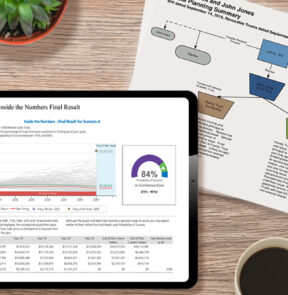On March 27, 2020, the bipartisan $2.2 trillion Coronavirus Aid, Relief, and Economic Security (CARES) Act (the “Act”) was signed into law, providing economic relief to households, businesses, and industries impacted by the coronavirus pandemic. Below is a summary of the key provisions as they relate to individuals and families.
Required Minimum Distribution Requirements Lifted for 2020
The CARES Act eliminates the Required Minimum Distribution (RMD) requirements for traditional IRAs, inherited IRAs, and defined contribution plans for 2020. By not taking RMD payments, investment accounts can recover from recent stock market volatility and taxpayers can avoid current ordinary income tax on distributions. Note that 2019 RMD payments that were delayed until 2020 for those turning 70½ during 2019 are no longer required, allowing an individual who turned 70½ in 2019 but delayed taking their first RMD until 2020 to avoid both the 2019 and 2020 RMDs.
UPDATE: Account holders who already took an RMD in 2020 now have until August 31, 2020 to return those funds as part of a tax-free rollover. When the Act was initially passed in March, individuals who had already taken their RMD could only return the distribution, tax-free, if the distribution was made within the last 60 days. In addition, if the distribution was from an IRA, returning such distributions were subject to the “one rollover per 12 months” rule, meaning that an individual could only rollover a distribution to the same or another IRA if he or she had not completed another rollover in the last 12 months. Further, inherited IRA beneficiaries, such as non-spouse beneficiaries, were ineligible to rollover RMDs already taken in 2020. This denied many the option to take advantage of the RMD relief provided by the Act.
On June 23, 2020, the IRS expanded the relief available to those who already took their RMD in 2020. Under the new IRS guidance, account holders who received a distribution that would have been an RMD in 2020 are not subject to the 60 day rollover period and instead have until August 31, 2020, to rollover their distribution. With respect to IRAs, the “one rollover per 12 months” limitation is waived, and, as a result, account holders may return multiple RMDs that have been taken this year, so long as they do so by August 31. Further, the IRS guidance permits inherited IRA beneficiaries to return any RMDs already taken in 2020 to the distributing IRA, also by August 31.
Penalty-Free Early Distributions from Retirement Accounts
Generally a 10% penalty is imposed on withdrawals from retirement accounts made by owners who are not yet age 59½. The Act waives this 10% penalty for coronavirus-related distributions (CRDs) totaling up to $100,000 made in 2020 from retirement plans, including IRAs and 401(k)s.
Who qualifies for a CRD? To qualify as a CRD, the affected plan participant or IRA owner must either (i) be diagnosed with coronavirus or have a spouse or dependent diagnosed with coronavirus, or (ii) experience adverse financial consequences due to the coronavirus, such as being quarantined, furloughed, laid off, unable to work due to lack of child care, or have work hours reduced.
How are CRDs taxed and/or repaid? CRDs will either be subject to income tax or may be repaid. An individual who elects to pay federal income tax on a CRD may do so over three years, and the income will default to being split evenly between the 2020, 2021 and 2022 tax years.
Alternatively, a taxpayer can elect to have all income reported in 2020 if, for example, it would be beneficial for tax purposes. Individuals who opt to repay all or a portion of the distribution may do so, income tax free, within a three-year period from the date of distribution and without regard to annual retirement plan contribution limits. Amended returns may need to be filed for individuals who later repay all or a portion of the CRD that was previously included as income on a prior income tax return.
Modified Loan Rules for Employer-Sponsored Retirement Plans
The Act makes it easier for individuals who qualify for CRDs to borrow from employer-sponsored retirement plans, such as 401(k) and 403(b) plans. If an individual participates in a plan that includes a loan provision, the Act increases the loan limit from $50,000 to $100,000 for loans made within the 180 days of the March 27, 2020 enactment of the Act. In addition, repayment on loans due anytime between March 27, 2020 and December 31, 2020 can be extended for up to one year.
Expansion of Charitable Contribution Tax Deductions
$300 Charitable Contribution Deduction for Non-Itemizers. For those who do not itemize deductions, the Act allows a taxpayer to take a $300 “above-the-line” deduction for cash contributions made to public charities, private pass-through foundations, and private operating foundations. This $300 deduction is not allowed for contributions to donor-advised funds or supporting organizations.
Increased AGI Limits for Itemizers. Individuals who itemize deductions can deduct up to 100% of their adjusted gross income (“AGI”) for cash contributions to public charities, private pass-through foundations, and private operating foundations, but not for gifts to donor-advised funds or supporting organizations. Any excess contributions may be carried forward up to five years as a charitable contribution carryover, subject to future-year AGI deduction limitations. Taxpayers will need to make an affirmative election on their 2020 income tax return to take advantage of this increased deduction limit.
Economic Impact Payments
Starting in April, eligible Americans will receive nontaxable “economic impact payments” of $1,200 for individual and head of household filers and $2,400 for joint filers, plus an additional $500 for each dependent child under age 17.
Taxpayers with an AGI of up to $75,000 for individuals, $112,500 for individuals filing as head of household, and $150,000 for married couples filing joint returns, will receive the full payment.
Payments will be reduced as the taxpayer’s AGI exceeds these income limits, until payments are completely phased out. For example, for filers without qualifying children, payments will be completely phased out for individual filers with AGI exceeding $99,000, $136,500 for heads of household, and $198,000 for joint filers. Note that an additional $10,000 should be added to the upper limit of these income thresholds for each qualifying child.
Payment eligibility is based on the taxpayer’s 2019 income tax return, otherwise the taxpayer’s 2018 return. In addition, the IRS will use the information on the Form SSA-1099 or Form RRB-1099 to generate payments for senior citizens, Social Security recipients, and railroad retirees who are not otherwise required to file a tax return. Nonresident aliens, individuals who may be claimed as a dependent on another return, estates, or trusts are not eligible for the payments.
If a taxpayer’s income on their 2020 return would result in a larger payment, the taxpayer will receive a tax credit for the additional amount. However, if the income reported on a 2020 return would have resulted in a smaller payment than what was received, the taxpayer will not be required to repay the excess amount.
Taxpayers will receive payments via direct deposit information provided on a tax return filed after January 1, 2018. If the IRS does not have a taxpayer’s direct deposit information, the Treasury plans to develop a web-based portal to allow individuals to provide banking information, if they wish, or those individuals can wait and receive a check in the mail.
If you have any questions on the CARES Act provisions, please reach out to your Fiduciary Trust Company officer.


